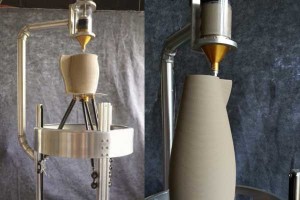 Remember that time when you took a ceramics workshop at the local community center? The potter’s wheel kept spinning out of control, you were covered in wet clay, and the coffee mug you made could’ve also doubled as a kindergarten art piece. Perhaps ceramics aren’t your forte, but you’d like to create a set of custom dinnerware to spruce up your home. Thankfully, 3D printing technology has gotten so advanced over the last year that robotic clay designs are now possible. Printer materials have continued to evolve, moving from simple plastic filaments to an advanced clay composite called Lay-Ceramic. Developed by Kai Parthy, a respected designer in the larger printing community, Lay-Ceramic is a filled filament that can be used with most conventional printers.
Remember that time when you took a ceramics workshop at the local community center? The potter’s wheel kept spinning out of control, you were covered in wet clay, and the coffee mug you made could’ve also doubled as a kindergarten art piece. Perhaps ceramics aren’t your forte, but you’d like to create a set of custom dinnerware to spruce up your home. Thankfully, 3D printing technology has gotten so advanced over the last year that robotic clay designs are now possible. Printer materials have continued to evolve, moving from simple plastic filaments to an advanced clay composite called Lay-Ceramic. Developed by Kai Parthy, a respected designer in the larger printing community, Lay-Ceramic is a filled filament that can be used with most conventional printers.
In theory, clay printing is highly intuitive because it employs a similar “coiling” technique that traditional potters use. Essentially, the extruder squirts clay in a spiral pattern, slowly building up layers and developing the object’s overall shape. Doing this by hand requires dexterity and skill, but it’s easy for a 3D printer, which opens up the possibility for distinctive, mass-produced ceramics. It’s difficult to create a vessel by hand because you need to maintain a constant rate of motion as you shape the material. On a 3D printer, however, a constant flow RAM extruder can realize a highly precise design without any peculiar bumps or weird accents (that is, unless you want the printer to do that)
Although some of the latest printers are equipped to handle clay filaments, most of them need a few modifications before you can create that new vase. For example, Lay-Ceramic requires an all metal hotend, which contains a nozzle, thermal isolator, heat source, and a holder for the extruder. A strong cooling fan is also needed, along with a hobbed bolt to hold the thick filament when it leaves the extruder. Once the object is finished printing, you’ll still need to fire it in a kiln to bind the clay together. From there, you can add glaze or paint intricate details on your pottery, ensuring that it stays in the family for generations to come.
Clay printing is still brand new, so the technology has plenty of room for improvement, but those possibilities are truly exciting. In the near future, you might be able to use a similar filament that’s filled with steel powder instead of clay powder, enabling consumer-level printers to build metal objects with ease. The adaptability of filaments allows makers to choose the perfect material for a particular project, owning one printer that can do everything. Traditionalists in the pottery and metallurgy worlds might be shaking their heads and bemoaning the end of an artistic era, but if anything, their unique craft will become even more valuable in light of this printing revolution.

3D printing is the future, and will disrupt so many industries in the next decade or so!